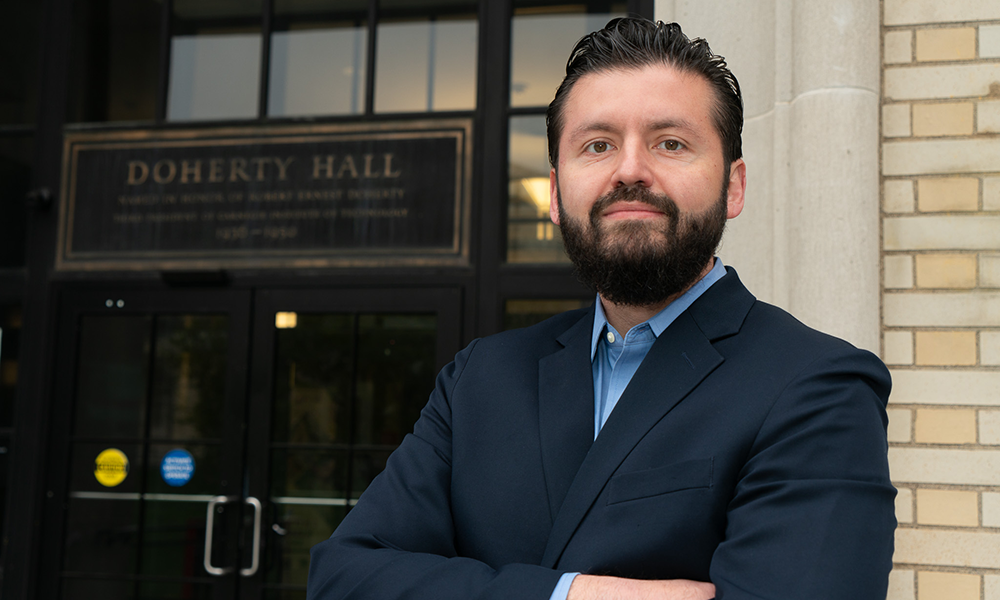Alum spotlight: Sebastián L. Vega
Emily Liu
Apr 24, 2024

Sebastián L. Vega ('06) is driven to inspire the next generation of professionals in STEM. His own mentors ignited his interest in chemical engineering, as well as biomedical engineering later down the line. And Vega, now an assistant professor at Rowan University, is eager to pay it forward.
Vega grew up in Pittsburgh, only a stone's throw away from Carnegie Mellon University. He discovered his calling in high school, where his chemistry classes and engineering projects showed him that STEM could be fun. "I put two and two together," he says. "Chemistry is cool. Engineering is cool. Boom, let's do ChemE."
Vega fondly remembers his undergraduate career at CMU. When he wasn't playing basketball with friends, he was spending countless hours studying in Hunt Library and working on lengthy problem sets in the ChemE cluster. Biological Transport and Drug Delivery, taught by Professor Robert Tilton, was one of Vega's favorite classes. He was fascinated by the idea of applying chemical engineering principles in the context of the human body. "That class really made me want to pursue a career in the biomedical space, with some ChemE roots," says Vega.
He majored in both chemical engineering and biomedical engineering and after graduating worked as a process engineer at Samsung Austin Semiconductor. But before long, Vega was reminded of Tilton's class and how much he'd enjoyed being immersed in academia at CMU. With that in mind, he left industry and went back to school.
After completing a Ph.D. in chemical and biochemical engineering at Rutgers University, followed by a postdoc in bioengineering at the University of Pennsylvania, Vega realized that he loved research. "It was early on in my postdoc when I said to myself, 'I want to be a professor someday,'" Vega recalls. "And that's how I ended up at Rowan University." His research lab, founded in 2018, uses principles from materials science and synthetic biology to study how cells sense and respond to biomaterials. Vega applies this knowledge to develop materials with applications in cell manufacturing and regenerative medicine. He also now teaches a biotransport class, just like the one he took with Tilton.
Vega's lab works with human mesenchymal stem cells or MSCs, adult stem cells found in bone marrow and fat. MSCs have the potential to differentiate into several cell types, including cartilage-producing chondrocytes and bone-producing osteoblasts. However, when cultured in the lab, MSCs tend to lose that potential. Vega's goal is to understand why.
In 2023, Vega received the CAREER Award from the National Science Foundation, one of the most prestigious awards granted to early-career faculty. Funding from this award is being used to study how material properties influence the differentiation potential of MSCs and to develop materials that help MSCs retain their stem cell identity outside of the human body. He hopes that this research will result in strategies to produce high-quality stem cells in large numbers, in order to increase the clinical use of MSCs.
I think mentors and role models are important. To-date, almost 200 high school students have participated in my outreach programs. I hope that, whether directly or indirectly, I continue to inspire as many people as possible.
Sebastián L. Vega, Assistant Professor, Rowan University
Vega makes a positive difference through outreach as well. During the COVID-19 pandemic, he started a virtual program called BioEngineering And Me. The BEAM program, open to applicants around the world, allows high school students to take a two-week crash course in engineering and biology. It culminates in a friendly round of Kahoot!, complete with prizes like BEAM t-shirts and hats.
Vega also runs Research Immersion in biomedical Science and Engineering at Rowan, a six-week summer research experience for South Jersey students. The RISER program, designed to increase accessibility to in-person research, provides high school juniors with an opportunity to work in Rowan University's biomedical labs. At the end of the program, each student presents their research at a culminating symposium that consists of research talks and a poster session. Parents, family members, and host lab personnel all come together to celebrate the students' achievements.
Vega expresses great pride in all of the students he's taught. "I think mentors and role models are important," he says. "To-date, almost 200 high school students have participated in my outreach programs. I hope that, whether directly or indirectly, I continue to inspire as many people as possible."
